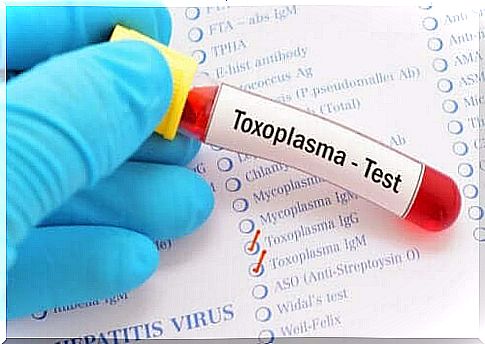Ocular Toxoplasmosis: Diagnosis And Treatment
Ocular toxoplasmosis can cause blurred vision, sensitivity to light, and pain in the eyes. However, diagnosing this condition is more complex, and in today’s article we’ll explain why.

Ocular toxoplasmosis is a disease caused by the parasite Toxoplasma gondii . It is a very common infection that affects approximately 500 million people worldwide. However, not all infected people develop this pathology, which only affects the eyes.
People with symptoms or consequences of ocular toxoplasmosis either have weakened immune systems or acquired the infection in the womb before birth. Unfortunately, ocular toxoplasmosis often leads to eye damage, blurred vision, and even blindness.
What Exactly Is Ocular Toxoplasmosis?
In order for you to understand what ocular toxoplasmosis is, we must first explain how this parasitic infection develops. Toxoplasma gondii reproduce and live in cats. In addition, the animals excrete these bacteria with their faeces.
However, this is only one of the possibilities for infection. Because many people become infected because this parasite is also often found in fruit, vegetables, meat, dairy products and even in water. As you can see, anyone can become infected with it if they consume a contaminated and uncooked product.
In addition, pregnant women who come into contact with the Toxoplasma parasite can transmit it to their unborn baby. This is because the parasite can penetrate the placenta and get to the fetus.
In fact, the latter case is the one most commonly associated with ocular toxoplasmosis. The severity of the fetal damage depends on the stage of pregnancy at which the contact occurs. Therefore, the first trimester is at the highest risk of malformations and complications.

causes
The infection is usually asymptomatic at first. However , reactivation can occur some time after contact. This then leads to an eye injury that leaves a scar that usually goes unnoticed.
When the infection is reactivated, the specific symptoms of ocular toxoplasmosis appear. This happens when the parasite becomes lodged in the retina – the part of the eye that allows the interpretation of images and the sense of sight. The retina becomes inflamed (this process is called retinitis), which affects vision.
A study by the Society of Ophthalmology found that recurrent ocular toxoplasmosis is the most common form. However, it can also occur in association with AIDS or during ongoing treatment with corticosteroids or immunosuppressants.
How is ocular toxoplasmosis diagnosed?
Diagnosing ocular toxoplasmosis can be complex. Also, doctors should monitor them clinically – that is, they need to watch the eye lesions. Because the tests available can only confirm whether or not there has been contact with the parasite.
For example, serologies that can be used to determine whether antibodies to this infection are present only indicate whether the patient has ever had the infection. However, there are also many people who are infected with the parasite but who have not developed ocular toxoplasmosis.
What an ophthalmologist can see right away is a focal lesion of the retina along with a scar that also affects the choroid – another membrane that is part of the eye.
Although laboratory tests can help diagnose, they cannot confirm it. Therefore , it is important that a specialist does a thorough eye exam so as not to miss the almost invisible signs.

Ocular toxoplasmosis: treatment
Ocular toxoplasmosis causes blurred vision, eye pain, and sensitivity to light. In some cases it can even lead to blindness. Unfortunately, there is still no treatment that can reverse the injuries.
Treatment helps prevent the extent of retinal damage and further relapses. A combination of antiparasitic drugs such as pyrimethamine and sulfadiazine is intended to prevent the parasite from multiplying and spreading.
In addition, the therapy is often supplemented by methylprednisone. This is a corticosteroid that reduces inflammation. In addition , doctors often prescribe folic acid supplements to avoid the side effects of pyrimethamine.
Preventive measures
The most effective way to avoid ocular toxoplasmosis is to take preventative measures against it. Therefore , doctors recommend properly cooking all food. Because this can significantly reduce the risk of infection. In addition, pregnant women should attach great importance to adequate hygiene measures when in contact with cats.
If you experience any symptoms in yourself, you should see a doctor. Because the quick detection of injuries in the eye can help to avoid worse eye damage.









